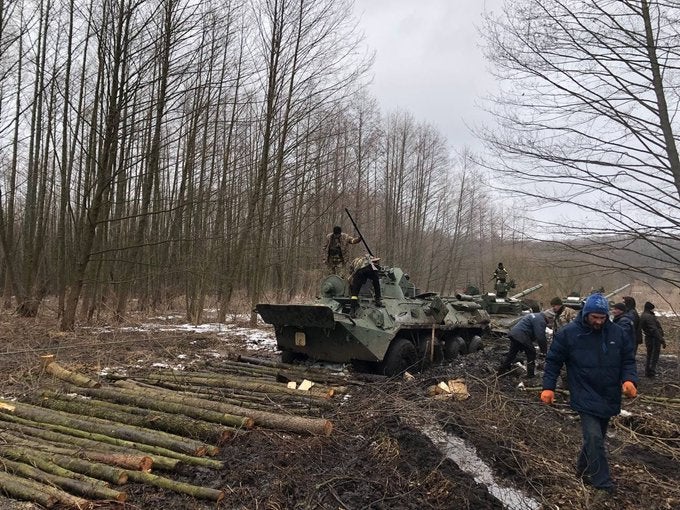Ruso-Ukranian War: Seven Days In
On 24 February at 4:00AM Ukrainian Time, Vladimir Putin announced his “special military operation” in Ukraine. Moments later, explosions rocked key Ukrainian cities including the capital of Kyiv, the strategic port of Odessa, as well as cities closer to the Russian border such as Kharkiv. Airborne forces landed in Hostomel Airfield north of Kyiv while Russian columns entered Ukrainian territory from Belarus, Crimea and Russia proper. This invasion was the culmination of months of military build up which American intelligence had repeatedly warned was the leadup to an invasion. Yet once more coherent information began to surface in the coming hours and days, it soon became apparent that Russia failed to achieve its strategic objectives. The elite airborne forces dropped at Hostomel were repulsed and scattered while Russian progress was generally slow on all fronts.
It appears that Putin envisioned a lightning strike along multiple axis of advance which would overwhelm an unprepared Ukrainian army and decapitate Ukrainian national and military leadership. However, likely with the support of US and allied intelligence, the Ukrainian army was well-prepared and managed to stall the Russians with an initial fighting retreat that drew in the Russians to more defensible positions.
In the first few days, despite what would appear to be overwhelming superiority in the quality and quantity of aircraft, the Russians failed to gain overall air superiority. They also failed to destroy Ukrainian communications: access to internet, television and mobile phone service. They failed to cause a collapse of Ukraine’s regular army. They failed to decapitate Ukrainian leadership. As of today, these objectives have not yet been achieved. After three days, the Russian army was forced to give up on its plan for a blitzkrieg, regroup its forces, and amend its invasion plans.
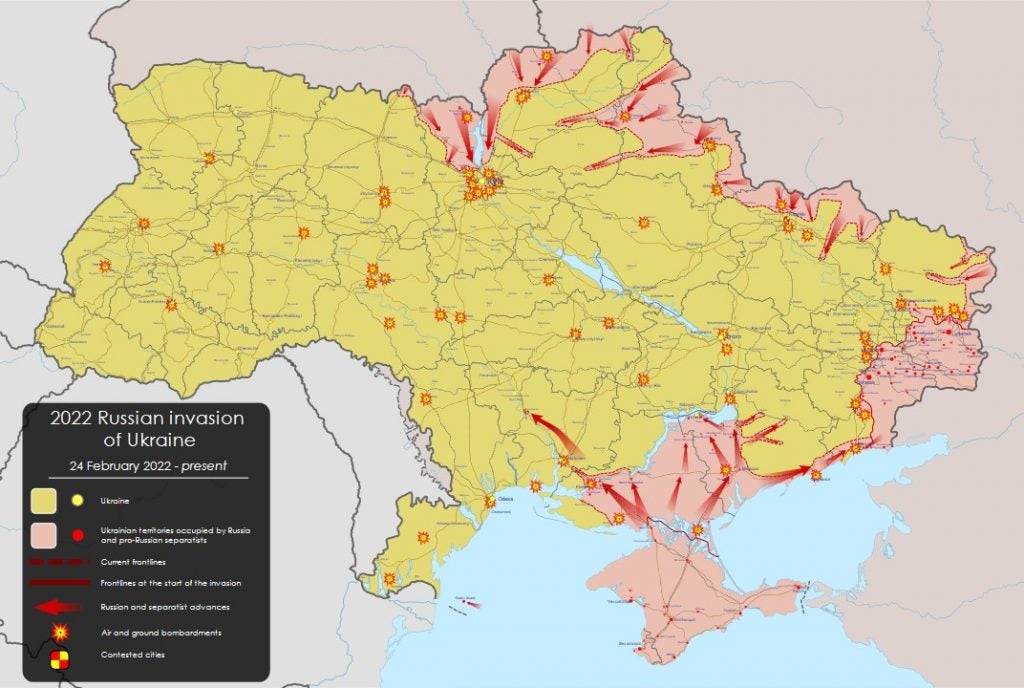
An Overview of the Major Fronts
One of the key areas of operations for the Russian military is the Kyiv area. Taking the capital would be key for successfully decapitating the Ukrainian military and government. Russian forces advanced from Belarus both East and West of the Dnieper River with Chernobyl reportedly falling under Russian control within 24 hours of the invasion starting but were unable to reach the airborne forces deployed at Hostomel in time to stop their destruction. By the 26th, Russian forces advancing from the Chernobyl area reached the outskirts of Kyiv. By the 27th, Russian forces East of the river had also reached the edges of the city. However, while Russia intensified bombardments of the city and despite the presence of Russian saboteurs in the Ukrainian capital, little progress has been made on this front. Ukrainian defenses are reportedly holding strong and attempts to encircle the city have seen as little success as the initial assault on the urban center itself.
On March 1, Ukraine alleged that despite Lukashenko’s assurances, Belarusian troops have joined Russian troops in Ukraine although this has not yet been independently verified. Much attention has been drawn to the massive convoy approaching Kyiv through the Chernobyl area which some estimates say may include as many as 1,500 vehicles.
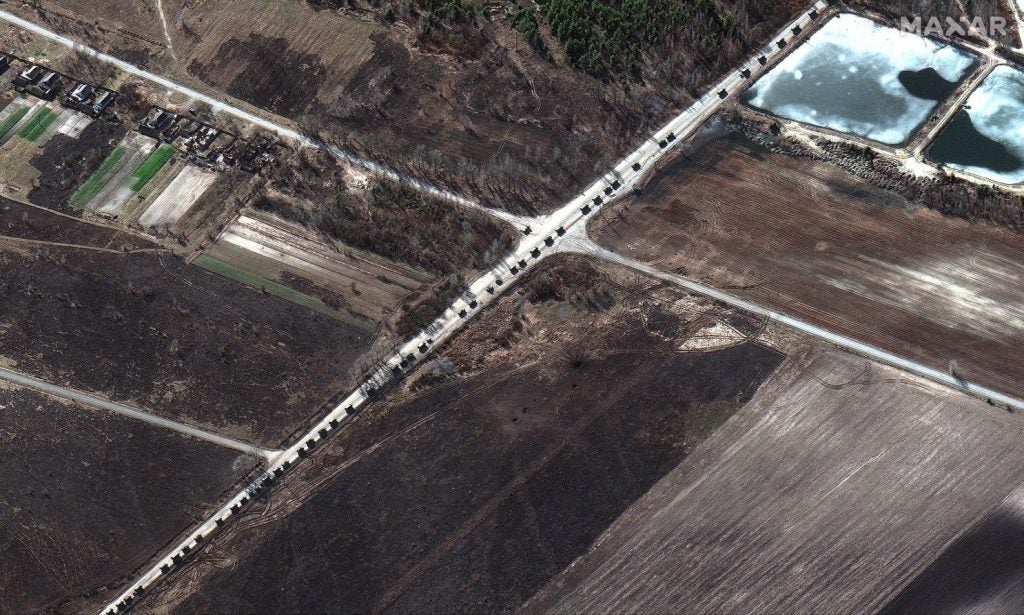
In the South, Russian forces invaded from Crimea moving north on Kherson and east to link up with Russian forces advancing from Russia proper and the Donbass region. Two cities in south-east Ukraine, Melitopol and Mariupol, became the main centers of resistance against the eastern advances. Russia claimed to have seized Melitopol on February 26 and the city’s fall was confirmed on March 1 by British and American intelligence. When exactly the city fell, however, is unclear.
While the coastal city of Berdiansk was also confirmed to have fallen, fighting for Mariupol, situated further east, continues. The city of Kherson, meanwhile, saw heavy fighting since the 24th with the city being confirmed to have fallen intro Russian hands on March 2. Ukrainian forces are expected to have retreated north down Highway M14 to set up a new defense based around the city of Mykolaiv. Ukrainian defenses along the Dnieper, West of Kherson, also appear to remain in place. As a key logistics hub, Kherson could be one of the first major areas for guerrilla warfare.
On the Eastern front, while the front near the newly declared separatist republics saw little change, Russian forces continue to besiege Kharkiv and Sumy further north, with the latter reportedly being surrounded. Both urban centers are right on Russia’s border. Kharkiv is the more major city and, with the exception of Kyiv, arguably has the greatest symbolic significance of any city currently under siege. The city has a rather large ethnically Russian population and was the site of significant fighting during World War II. The city’s central square, now called “Freedom Square”, once hosted a statue of Lenin and in Soviet times was named after Felix Dzerzhinsky, the founder of Bolshevik state intelligence apparatus.
It should be noted, that the fighting for the cities is accompanied by heavy bombardment by rockets, missiles and artillery. These have become increasingly severe and indiscriminate following the failure of the Putin’s initial attempt at a lightning strike.
Talks between Ukrainian and Russian officials took place on February 28 and on March 2 but these reportedly made little progress.
Losses and Refugees
On February 28, American intelligence claimed that Russia had suffered up to 2,000 deaths. At the time, Ukraine claimed the Russians had suffered 5,300 casualties. To put these figures into context, 2,500 Americans were killed over the course of two decades in Afghanistan. As of March 1, Ukraine claims it has destroyed nearly 198 tanks, 846 armored fighting vehicles, 305 other vehicles and 77 artillery systems in addition to shooting down 29 helicopters, 28 aircraft and 2 Ilyushin Il-76 transport aircraft. On March 2, the Ukrainian Army claimed that the Russians have suffered over 7,000 casualties. This day was also the first time Russia admitted to any significant losses with claims of 498 killed and 1,597 wounded.
Russian figures from March 2 meanwhile put Ukrainian losses at 2,870 killed and 3,700 wounded. US intelligence put Ukrainian military losses at around 1,500 killed as of February 28h. In terms of land vehicles, Russia claims to have knocked out over 800 and to have destroyed 58 aircraft, 7 helicopters and 46 drones.
Of course, these numbers are all impossible to verify but video and images available online prove that Russian losses must indeed be very high. Moreover, it is clear that the Ukrainian army has managed to capture many Russian vehicles. However, the comparatively limited amount of open-source intelligence related to Ukrainian losses means that it is hard to make inferences about the state of the Ukrainian Army. Notably, images show that Russian vehicle losses also include some of the Kremlin’s more most modern equipment including T-90 tanks and Ka-52 helicopters.
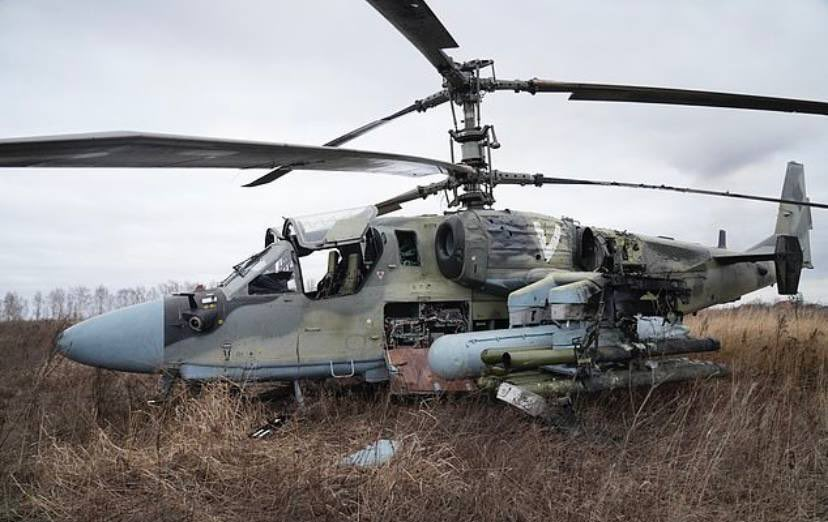
As of March 3, the United Nations claims that over one million refugees have left Ukraine with over half coming to Poland which has lifted all visa restrictions for Ukrainians. Moreover, over a million Ukrainians are said to be internally displaced.
Ukraine claims over 2,000 civilians have been killed by Russian attacks.
Poor Performance of the Russia Army
The Russian military has thus far demonstrated poor performance. Despite continued drone attacks and a somewhat operational Ukrainian Air Force, Russia acts as if it has gained air superiority. Vehicles drive with air identification markings and countless convoys have been destroyed due to seemingly failing to account for Ukrainian drones and air power. The fact that two transport planes were reportedly shot down over Kyiv on February 26 can be largely attributed to failing to appreciate Ukrainian air and air defense capabilities. Considering Russia’s much larger and more modern air force, the fact that Ukraine can still put up a fight in the air is difficult to explain.
Moreover, in addition to suffering catastrophic losses, Russian forces have demonstrated low morale. With the exception of elite units like the VDV, videos of captured Russians calling their families seem to reveal that the average Russian soldier, and even officers, were not informed they were invading Ukraine until after they had already crossed the border. This may help explain the large amount of abandoned Russian vehicles; US intelligence reported that some Russian units were puncturing their vehicles’ fuel tanks as a pretext to leave the battlefield. There have also been reports of Russian marines refusing to carry out landing near Odessa although this has not been verified. Ukraine is hoping to exploit this situation and has recently began offering $40,000 and asylum to any Russian soldier who defects.
Another key shortcoming is Russian logistics which are in a catastrophic state. Food, fuel and ammunition are not reaching the frontlines leading to further plummeting morale and more abandoned vehicles. It also goes without saying that without fuel, vehicles aren’t going to be going any deeper into Ukraine. Poor logistics preparation is made worse by successful Ukrainian attacks on Russian convoys and a reported lack of secure communications equipment. US Department of Defense officials have stated that, as of March 3, they believed the convoy north of Kyiv has stalled due to logistics failures.
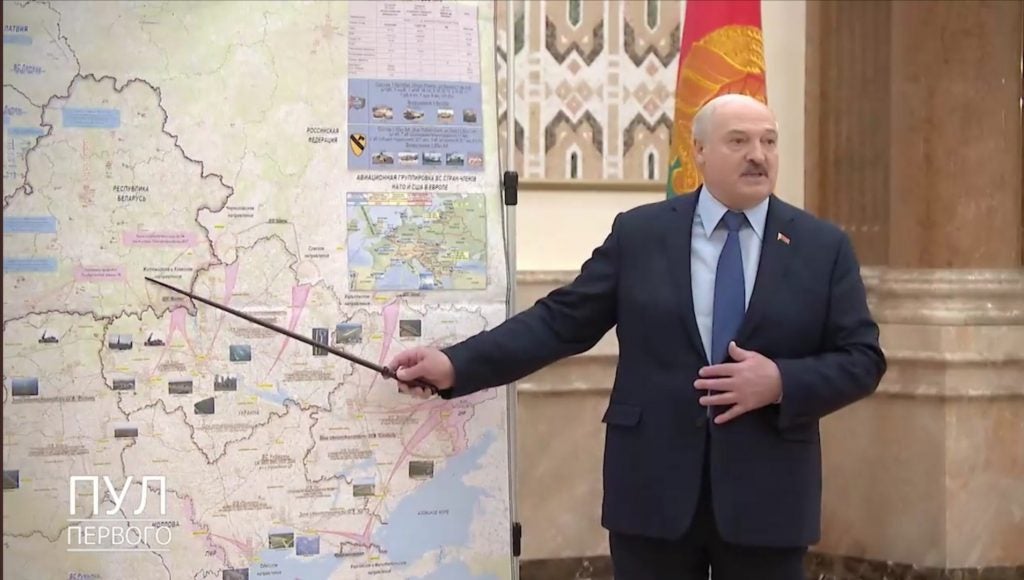
Furthermore, Russian forces have shown abysmal operational security. Perhaps the most striking example of this was Belarusian dictator Lukashenko publicly displaying a map showing planned axes of advance on March 1. Russian forces have also initially failed to take down cameras livestreaming their troop movements. Little has been done to prevent Ukrainian citizens taking video of Russian troops which can later be used to locate individual convoys and Ukraine has set up an online system for civilian to report enemy troop movements. Overall, it seems that Russian forces lack the police troops needed to control the Ukrainian citizenry which has shown remarkable bravery blocking Russian troop movements on the streets even as Russian soldiers aimed rifles in their direction and fired shots into the air.
Of course, the current state of affairs did not come solely from Russian blunders. While Ukraine did not order a general mobilization during the Russian buildup in fear of provoking Russia, its forces have demonstrated high morale and the capability to cause serious harm to the Russians. It seems that the Ukrainians are acting on excellent intelligence, likely supported by the West. Despite a week of combat, on March 1, Ukraine was still able to launch a Tochka-U ballistic missile strike on an airbase inside Russia.
The Information War
A major front of the Ukrainian war is in the information sphere. Early in the war, hackers sympathetic to Ukraine, including the famed “Anonymous”, were able to carry out attacks which brought down key websites including those of the Russian state news/propaganda outlet RT, the fossil fuel giant Gazprom and a number of Russian government websites. On the 25th, hackers were able to leak a database of Russian defense ministry employees and their account details. On March 1, Anonymous claimed it had shut down the control center of Russia’s space agency Roscosmos which resulted in the loss of control over Russian spy satellites. This claim has not been confirmed and was denied by Roscosmos but while unlikely, it could be one of the most damaging cyberattacks in history if true.
Moreover, Ukraine has thus far been able to maintain high citizen morale with its information strategy. Videos showcasing burning Russian tanks, citizens coming together to produce molotovs and build tank traps, surrendered Russian soldiers and drone strikes have all contributed to creating an image of a successful Ukrainian war effort. President Zelenksy’s decision to remain in Ukraine and his continued media presence has inspired the citizens of Ukraine as well as many beyond its borders. Ukraine’s success in keeping its communications networks running, now made more feasible in the long term with the arrival of Elon Musk’s Starlink satellite communications kits on the 28th, has made this all possible.
However, the information war is not completely one-sided. On February 24 and 25, misinformation spread by Russian groups helped create panic in Poland by reporting a shortage of fuel. This resulted in massive lines to gas stations in some cities. According to information Overt Defense received from volunteers working on the Polish border, Russian saboteurs in Ukraine have spread misinformation to refugees claiming that Polish authorities will force them to work without compensation for six months for the support they receive or that passports will be confiscated at immigration processing points. If Russia succeeds in further degrading Ukraine’s communication network, Russian misinformation will likely become more prominent, with some fearing the Russians may attempt to cut off Zelensky from the rest of the country and attempt to convince the rest of Ukraine that the national government has surrendered.
In Russia itself, however, it seems that the information war is not going too well. While polling suggests that only a minority of Russians opposes the invasion, the Kremlin is desperately trying to stop the spread of any information regarding the war to Russians other than Putin’s official version of events – a noble Russian peacekeeping intervention supported by the Ukrainian people aimed at removing ‘Nazis’, who are puppets of the West, from power. Russia had moved to restrict access to social media like Facebook and Twitter early on in the invasion. Sizeable protests in Russian cities were reported with thousands said to be arrested for demonstrating against the war. Restrictions grow daily with Russia reportedly banning publications from referring to the invasion of Ukraine as a “war” and the Kremlin shutting down the last remnants of independent Russian media on March 1- TV Rain and radio station Echo of Moscow.
The International Response
Russia’s invasion was met by waves of protests throughout the world. Millions of protestors took the streets from Warsaw to Tokyo and from New York to Berlin and even in Russia (despite threat of arrest there). Once the world saw that Ukraine wasn’t folding but was holding the Russian advance back, the demand that democratic leaders act, and their willingness to do so, began to grow. Russia hitting a Japanese-owned cargo ship and killing ten Greek nationals on February 26 certainly didn’t help its case, nor did hitting and killing ships and citizens of a number of other countries.
The entire democratic world moved to sanction Russia. Despite initial hesitancy by some European states, many Russian banks have now been cut off from the SWIFT system although a full SWIFT ban has not been introduced. Nord Stream 2 is dead with its patent-holding company nearing bankruptcy as of March 1. Leaders from all over the world imposed sanctions on Russia and froze Russian assets. This includes not just NATO countries but also democracies such as Japan, Australia and even neutral Switzerland. Every day, additional assets are frozen and new sanctions are being imposed on Russia and the list of countries which have restricted Russian planes from flying in their airspace continues to grow.
The effects on Russia’s economy are severe. Long lines leading to ATMs have been reported as Russians are desperate to cash out money. The value of the Ruble crashed dramatically going from 81.50 Rubles for $1.00 to 109.55 to $1.00 on March. According to the Guardian, analysts say that sanctions could shrink Russia’s economy by 7%.
International aid has also come in the form of direct support. Countries in Europe and beyond have pledged to provide Ukraine with thousands of anti-tank missiles, small arms, ammunition and medical equipment. Germany has gone back on its policy of not supplying lethal aid with a commitment to provide 1,000 anti-tank weapons and 500 Stinger missiles on the 26th. Luxembourg promised 100 NLAWs, jeeps and military tents on the 28th. Finland promised 2,500 rifles, 150,000 rounds of ammunition, and 1,500 anti-tank weapons. There had even been talk of NATO potentially providing fighter aircraft to Ukraine which was reported by a number of major news outlets but government officials have denied this.
Ukraine is also assembling an international legion for volunteers willing to fight for Ukraine and people around the world have answered the call. While few statistics have thus far been released, 70 Japanese citizens have volunteered (50 former JSDF, 2 former French Foreign Legion). It is also known that some volunteers are organizing online using groups such as r/volunteersForUkraine on Reddit.
Moreover, Russia has not just faced condemnation from its adversaries, but also little support from its allies. One key example is Kazakhstan which has refused to send troops to support Putin or recognize the breakaway republics Putin claims he is defending. Instead, it has sent aid to Ukraine. Similarly, China has been rather distant. After all, accepting the invasion of another country, or the sovereignty of a breakaway republic, would undermine China’s official stance on sovereignty and yield legitimacy to Tibet’s and Taiwan’s independence movements. In a vote to condemn Russia in the UN general assembly, 141 countries voted in favor, 34 abstained and 5 were against: Russia, Syria, North Korea, Belarus and Eritrea.
While the situation has so far unfolded much more favorably for Ukraine than most would have predicted before the invasion, an outright Ukrainian victory is unlikely and continued success in holding Russian offensives is not assured. At the end of the day, Russia still has an overwhelming advantage in numbers and equipment. However, it seems that even if the Russians manage to eventually seize the country, Ukraine will not be a geopolitical victory for the Russian state. NATO, the EU and the wider democratic world have been brought closer together, the image of Russia’s military having world-class capability has been shattered and Ukraine has shown that its citizens would likely sustain a costly resistance for years after a Russian takeover and installation of a puppet regime.

